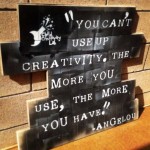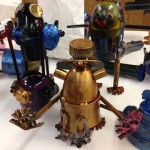To Enhance Creativity in Children
This week, our friend and guest blogger, Peter Chang, will tell us about his organization, Child Creativity Lab, and how they are leveraging the Maker Movement to enhance creativity in children. Be sure to check out Child Creativity Lab on the web to learn more about upcoming events and how you can get involved!
We had no idea what we were making, but it was exhilarating and the anticipation of something great motivated us to keep hammering away without even a notice of being in the overly dry heat of a Southern California summer.…
The Child Creativity Lab (CCL) is a planned children’s museum with emphasis on enhancing creativity in children. While awaiting the establishment of the permanent museum, we operate our flagship program, the CCL Museum-on-Wheels, consisting of a mobile educational service that travels to partner locations, focused on creativity-enhancing stimulation and inspiration for pre-kindergarten through 6th graders. Educational workshops focus on age-appropriate STEM-based activities helping to guide participants in bringing together existing ideas into new configurations, developing new properties or possibilities for something that already exists, and discovering or imagining something entirely new.
The same formidable uphill street that we habitually dreaded riding our bikes on to get home was now intriguing us with something new…a downward slope!
Our specific programs range from storyboard design to bring adventures and personalities to life; various art disciplines introducing children to new ways of seeing and thinking; and other activities supporting increased patience, concentration, and processing and sequencing skills. With that said, the common thread reverberating through ALL of our activities is the passion to embed a culture and appreciation for hands-on “making”.
An old skateboard, a discarded piece of plywood, miscellaneous remnants at a local construction site, and gardening gloves turned out to be a treasure trove of parts for our proud two-person, gravity-powered, customized go-cart that provided hours and hours of thrilling trips down Santa Anita Avenue.
We owe much of our inspiration and success to the Maker Movement on a number of different levels. The movement has generated much needed appreciation of the importance of inventing, designing, and tinkering. This has helped to create increased pre-existing awareness and enthusiasm in children and families coming into our programs, which would have been met with more suspicion and unknowingness prior to days before the Maker Movement. The recent trends have also spawned an endless stream of different ideas for projects and activities that we’ve been able to tweak and incorporate into educational programs specifically designed for children. Finally, and most important to our organization, the Maker Movement has highlighted the issue of the decline in creativity that we’ve seen over the last couple of decades. While once the leader of the world in innovation, “children (in America) have become less emotionally expressive, less energetic, less talkative and verbally expressive, less humorous, less imaginative, less unconventional, less lively and passionate, less perceptive, less apt to connect seemingly irrelevant things, less synthesizing, and less likely to see things from a different angle.”[1]
While our shoes were worn down from being our quasi brake pads and we came away with scraps and cuts from crashes that we deemed as necessary learning moments that demanded us to continually refine our vehicle contraption, we learned about and expanded our creative abilities and had tons of fun in the process.
As a child growing up, I have very fond memories of tinkering away on inspiring and creativity-building projects in my best friend’s backyard. As an organization dealing with the current headwinds of the busy lifestyles of dual-working parents, the consuming technology culture of our youth, and standardized testing, we hope to provide the same memories for the children in Orange County.
[1] Kim, K, “The creativity crisis: the decrease in creative thinking scores on the Torrance Tests of Creative Thinking”, Creativity Research Journal, 23:4, 285-295; 2011


